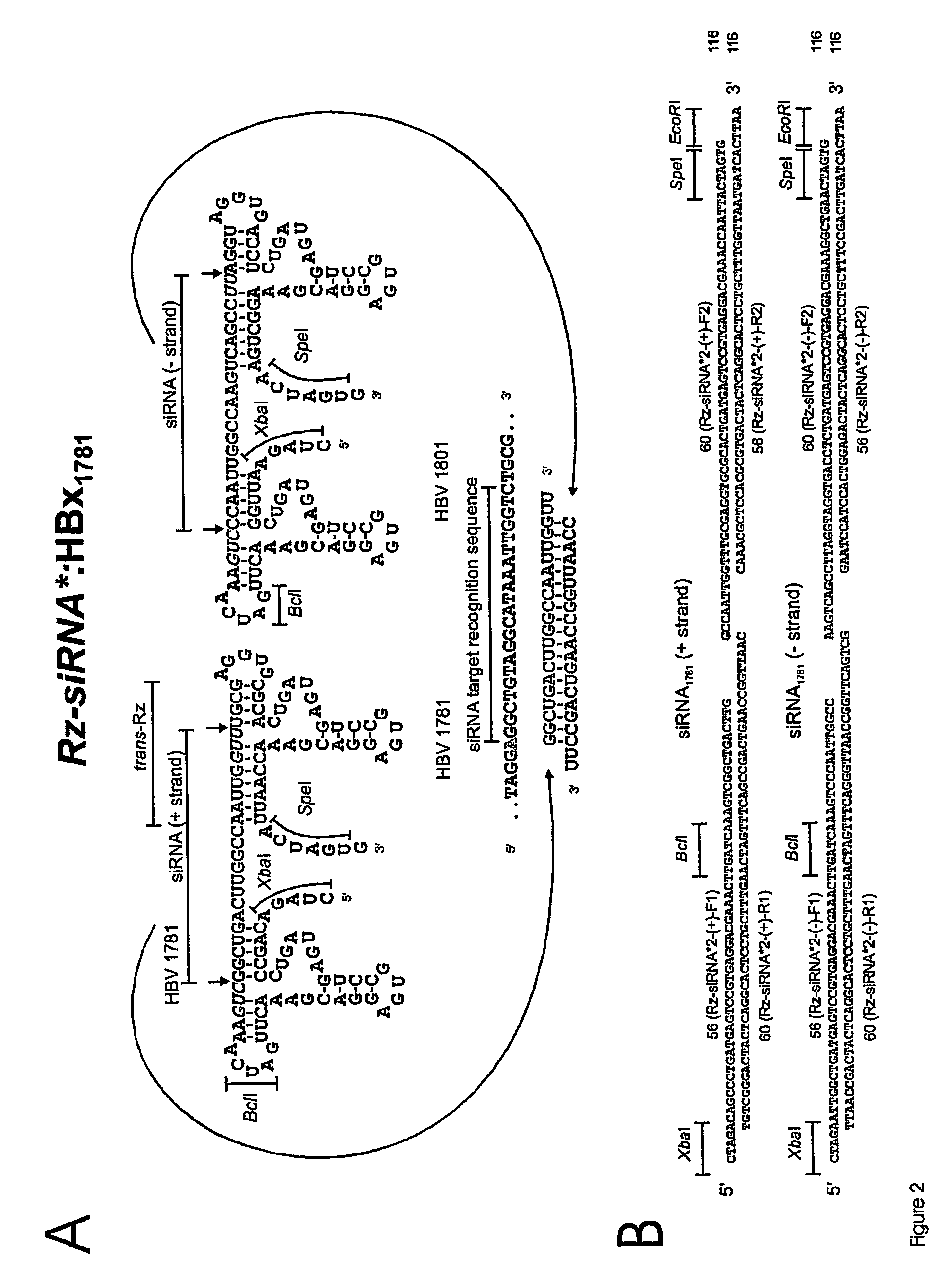Self-Processing Rna Expression Cassette
a self-processing, cassette technology, applied in the direction of biochemical equipment and processes, organic chemistry, gene material ingredients, etc., can solve the problems of inability to effect rnai in mammalian cells, modification may have adverse toxic effects, and the sirna may not be suitable for in vivo use, so as to reduce gene transcription and preserve the effect of longevity
- Summary
- Abstract
- Description
- Claims
- Application Information
AI Technical Summary
Benefits of technology
Problems solved by technology
Method used
Image
Examples
example 2
Synthesis and Characterisation of Constructs Encoding shRNA and Ribozyme Sequences
[0186]2. Generation of Cassettes Encoding Ribozyme and shRNA Sequences that Target HBV
[0187]These methods describe the preparation of constructs encoding 5′ and 3′ cis-acting hammerhead ribozymes that flank a shRNA encoding sequence.
[0188]FIG. 5 shows a generic ribozyme template for the production of shRNA sequences. Oligodeoxynucleotides were designed which include 5′- and 3′-flanking hammerhead ribozymes that were designed to cleave 3′ of 5′ NUH 3′ triplets (red) (FIG. 5A) to generate shRNA (FIG. 5B), which in this example contains signature miR-30 loop and stem base regions. Mismatches may be incorporated into the stem region of the hairpin to facilitate incorporation of the appropriate single stranded guide RNA sequences (antisense) into RISC. In this example, unique XhoI and SalI restriction sites were included in the oligodeoxynucleotides to enable insertion of the oligodeoxynucleotides into Pol ...
example 3
Identification of Susceptible siRNA and shRNA Targets of HBV
[0199]3.1 Generation of shRNA Expression Constructs which Include the U6 Promoter
[0200]To identify HBV sequences within the HBV X ORF that are susceptible to knockdown, a panel of 10 shRNA expression constructs under the transcriptional control of the U6 promoter (an RNA polymerase III promoter) was generated. The schematic outline of the procedure used to generate the cassettes comprising the U6 promoter together with short hairpin-encoding sequence is depicted schematically in FIG. 10. Briefly, oligonucleotides encoding the short hairpins were designed. The sequences were:
5′-TGACGTGACAGGAAGCGTTAGCAGACACTTGGCATAGGCCCGGTGTTTCGTCCTTTCCACA-3′ (U6shRNA2.1),5′-CCCAGATCTACGCGTAAAAAAGGTCTGTGCCAAGTGTTTGCTGACGTGACAGGAAGCGTTA-3′ (U6shRNA2.2),5′-GGACGTGACAGGAAGCGTTCGTGGGATTCAGCGTCGATGGCGGTGTTTCGTCCTTTCCACA-3′ (U6shRNA6.1),5′-CCCAGATCTACGCGTAAAAAACCGTCGGCGCTGAATCCCGCGGACGTGACAGGAAGCGTTC-3′ (U6shRNA6.2),5′-CTTTATGACAGGAAGCAAAGAGAGATGCG...
example 4
In Vivo Assessment of Efficacy of Anti HBV shRNA Constructs Using the Murine Hyperdynamic Tail Vein Injection Method
[0204]The murine hyperdynamic tail vein injection (MHI) method was employed to determine the effects of shRNA plasmid vectors on the expression of HBV genes in a small animal model of HBV infection. A large volume of DNA-containing saline solution is injected into the tail vein over a short period of time. Usually 10% of body mass (e.g. 2.8 ml of solution into a 28 g mouse) is injected over 5-10 seconds. This results in a rapid, but transient, rise in intrahepatic back pressure that delivers DNA efficiently to hepatocytes. Thus injection of pCH-9 / 3091 plasmid DNA results in expression that mimics HBV infection.
[0205]In a typical investigation, mice were injected with a combination of three plasmid sequences:
[0206]1 Target DNA: HBV-encoding plasmid DNA (pCH3091) or pCIneo plasmid DNA that lacks an insert (negative control)
[0207]2 Anti HBV sequence: shRNA-encoding plasmi...
PUM
| Property | Measurement | Unit |
|---|---|---|
| temperature | aaaaa | aaaaa |
| pH | aaaaa | aaaaa |
| body mass | aaaaa | aaaaa |
Abstract
Description
Claims
Application Information
 Login to View More
Login to View More - R&D
- Intellectual Property
- Life Sciences
- Materials
- Tech Scout
- Unparalleled Data Quality
- Higher Quality Content
- 60% Fewer Hallucinations
Browse by: Latest US Patents, China's latest patents, Technical Efficacy Thesaurus, Application Domain, Technology Topic, Popular Technical Reports.
© 2025 PatSnap. All rights reserved.Legal|Privacy policy|Modern Slavery Act Transparency Statement|Sitemap|About US| Contact US: help@patsnap.com



